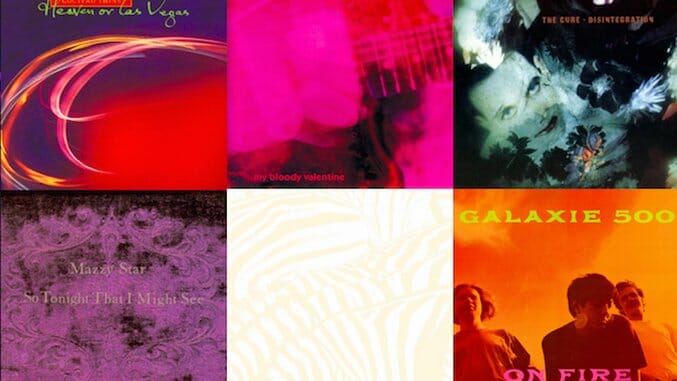
Like indie rock and alt-country and innumerable other subgenres, dream pop is a fluid set of sounds. There is no one right way to make a dream pop album, but when you hear a good one, you’ll know. One reason dream pop is so difficult to pinpoint is the genre’s emphasis on mood and tone over specifics. In a great dream pop album, chords and tracks blur seamlessly into one another so frequently that it can be difficult to even decipher when one song ended and another has begun. Additionally, dream pop usually prioritizes sonics over lyrics. You may listen to some of the records on this list and not understand a lick of what the vocalist is saying—that’s what makes them great! Dream pop artists aren’t poets—they’re painters patching together swaths of sound into a big, beautiful landscape. In dream pop, atmosphere is everything.
As we mentioned before, dream pop is difficult to define. Therefore, some of the albums on this list could very well belong on other lists. There’s overlap with genres like shoegaze, indie-pop, indie rock and synth-pop. We went with our gut on this one, but that’s why this list is special. We made sure to take various eras of dream pop into account—from its formation in the late 1980s via ethereal groups like Cocteau Twins and My Bloody Valentine to its 21st century iterations in outfits like Jay Som and Alvvays. While the albums on this list could be described a million different ways, they all tread similar sonic territory: that floaty, surreal, cloud-like haze most often associated with dream pop. View the full list below.
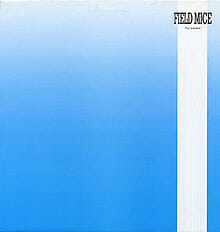 25. The Field Mice: For KeepsLegendary indie pop label Sarah Records put out lots of records that could make this list, but our pick for the best would be For Keeps, the sole full-length by the Field Mice. With shimmering guitars, yearning vocals, lovelorn lyrics, occasional forays into dance music (the band’s producer, Ian Catt, would later go on to work with St. Etienne) and an overarching delicacy that hits you right in the heart, For Keeps is a musically rich and emotionally devastating trip. Seriously, that one-two punch of “Willow” and “And Before the First Kiss” on side two never fails to break me up. Sad dreams, man. —Garrett Martin
25. The Field Mice: For KeepsLegendary indie pop label Sarah Records put out lots of records that could make this list, but our pick for the best would be For Keeps, the sole full-length by the Field Mice. With shimmering guitars, yearning vocals, lovelorn lyrics, occasional forays into dance music (the band’s producer, Ian Catt, would later go on to work with St. Etienne) and an overarching delicacy that hits you right in the heart, For Keeps is a musically rich and emotionally devastating trip. Seriously, that one-two punch of “Willow” and “And Before the First Kiss” on side two never fails to break me up. Sad dreams, man. —Garrett Martin
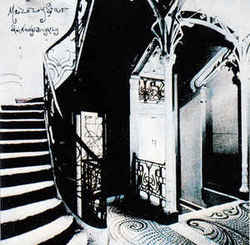 24. Mazzy Star: She Hangs BrightlyWhile Mazzy Star’s 1993 sophomore release, So Tonight That I Might See, is the album most people look to in the dream pop canon, this favoritism is largely propped up by the existence of sublime single “Fade InTo You,” while their debut album, She Hangs Brightly is a stunning work in and of itself. What So Tonight That I Might See offers in the purest sense of dream pop vibes, She Hangs Brightly runs circles around it in sheer folk psychedelia and mind-bending bohemia. From the album’s cover shot of architect Victor Horta’s art nouveau stairway at the Hotel Tassel in Brussels, singer Hope Sandoval and multi-instrumentalist David Roback operate in marbled nostalgia and lovelorn bliss. On “Give You My Lovin’” Roback’s slide guitar presents a gorgeous companion for Sandoval’s breathtaking delivery. Like a gentle gypsy, a tambourine rears itself throughout the album, memorably on “Ride It On,” a song that packs the defining gaze of the early ’90s. Largely recorded at San Francisco’s Hyde Street Studios, released on Rough Trade and later re-released by Capitol, She Hangs Brightly forever stands as a testament to the thrill of Sandoval’s heavenly coo, the genius of Roback’s instrumental explorations and of Mazzy Star’s audacity to dream. —Adrian Spinelli
24. Mazzy Star: She Hangs BrightlyWhile Mazzy Star’s 1993 sophomore release, So Tonight That I Might See, is the album most people look to in the dream pop canon, this favoritism is largely propped up by the existence of sublime single “Fade InTo You,” while their debut album, She Hangs Brightly is a stunning work in and of itself. What So Tonight That I Might See offers in the purest sense of dream pop vibes, She Hangs Brightly runs circles around it in sheer folk psychedelia and mind-bending bohemia. From the album’s cover shot of architect Victor Horta’s art nouveau stairway at the Hotel Tassel in Brussels, singer Hope Sandoval and multi-instrumentalist David Roback operate in marbled nostalgia and lovelorn bliss. On “Give You My Lovin’” Roback’s slide guitar presents a gorgeous companion for Sandoval’s breathtaking delivery. Like a gentle gypsy, a tambourine rears itself throughout the album, memorably on “Ride It On,” a song that packs the defining gaze of the early ’90s. Largely recorded at San Francisco’s Hyde Street Studios, released on Rough Trade and later re-released by Capitol, She Hangs Brightly forever stands as a testament to the thrill of Sandoval’s heavenly coo, the genius of Roback’s instrumental explorations and of Mazzy Star’s audacity to dream. —Adrian Spinelli
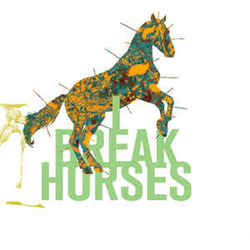 23. I Break Horses: HeartsI Break Horses’ debut album Hearts is a 40-minute exercise in the proper techniques for warping and wefting disparate sounds and styles together into the same fabric. Hearts finds consistency not in theme or even in tune, but rather in pacing: This is a record built to showcase the careful process of braiding together synth snares, double time drums, arpeggio scaling, distortion and nicely opaque lyricism, all with an emphasis on interludes that rise heavenward thanks to the collision of the record’s multiple competing aesthetics. Fuzzed-up one moment, clean the next; electronic one moment, earthly and even primal the next. This is music to enjoy a nature bath to. Walk to the middle of your favorite forest and listen to duo Maria Lindén and Fredrick Balck sing about death and darkness, among other such cheery topics. They’re Swedish. It comes with the territory. On Hearts, that band wades into that territory to pull off the neat trick of being heavily influenced by electronic instruments and electronic sounds while remaining devotees to nature for the duration. Hearts is, on the one hand, computerized almost entirely, or at least that’s the way it reads. On the other hand, it’s still a great self-made shoegaze record. —Andy Crump
23. I Break Horses: HeartsI Break Horses’ debut album Hearts is a 40-minute exercise in the proper techniques for warping and wefting disparate sounds and styles together into the same fabric. Hearts finds consistency not in theme or even in tune, but rather in pacing: This is a record built to showcase the careful process of braiding together synth snares, double time drums, arpeggio scaling, distortion and nicely opaque lyricism, all with an emphasis on interludes that rise heavenward thanks to the collision of the record’s multiple competing aesthetics. Fuzzed-up one moment, clean the next; electronic one moment, earthly and even primal the next. This is music to enjoy a nature bath to. Walk to the middle of your favorite forest and listen to duo Maria Lindén and Fredrick Balck sing about death and darkness, among other such cheery topics. They’re Swedish. It comes with the territory. On Hearts, that band wades into that territory to pull off the neat trick of being heavily influenced by electronic instruments and electronic sounds while remaining devotees to nature for the duration. Hearts is, on the one hand, computerized almost entirely, or at least that’s the way it reads. On the other hand, it’s still a great self-made shoegaze record. —Andy Crump
 22. DIIV: OshinFor most of DIIV’s debut album Oshin, it’s nearly impossible to understand what frontman Zachary Cole Smith is singing about, his vocals hazy and washed out to the point where they sound like just another instrument. But we don’t really need Smith’s words, as poetic as they are, to get the gist of the record: Oshin recalls summers come and gone, memories dissolving in the outer reaches of our brain, tinged with regret, self-loathing and heartbreak. Frequently gorgeous and occasionally dark, the album, the crown jewel of Captured Tracks’ early-2010s heyday, is hypnotic and easy to lose yourself in. From the wistful “How Long Have You Known” to the rockier “Doused,” Oshin’s sun-drenched grooves and mumbled melodies feel timeless and every bit as vital today as they did at the height of chillwave. —Steven Edelstone
22. DIIV: OshinFor most of DIIV’s debut album Oshin, it’s nearly impossible to understand what frontman Zachary Cole Smith is singing about, his vocals hazy and washed out to the point where they sound like just another instrument. But we don’t really need Smith’s words, as poetic as they are, to get the gist of the record: Oshin recalls summers come and gone, memories dissolving in the outer reaches of our brain, tinged with regret, self-loathing and heartbreak. Frequently gorgeous and occasionally dark, the album, the crown jewel of Captured Tracks’ early-2010s heyday, is hypnotic and easy to lose yourself in. From the wistful “How Long Have You Known” to the rockier “Doused,” Oshin’s sun-drenched grooves and mumbled melodies feel timeless and every bit as vital today as they did at the height of chillwave. —Steven Edelstone
 21. The Joy Formidable: The Big RoarThe Big Roar couldn’t be a more aptly titled debut for The Joy Formidable. The album’s first song “The Everchanging Spectrum of a Lie” is such a tidal wave of crashing drums, heavy guitar and lead singer Ritzy Bryan’s harsh/soft vocals, that it’s exhausting by the time it’s over. Joy Formidable are a band made for large arenas and even larger crowds. Fittingly, Foo Fighters chose them for their arena-packing tour back in 2011, and after with their sound evoking Metric and the best of ’90s era rock, it’s hard to imagine any stadium not left a little shaken even before Dave Grohl and co. took the stage. —Ross Bonaime
21. The Joy Formidable: The Big RoarThe Big Roar couldn’t be a more aptly titled debut for The Joy Formidable. The album’s first song “The Everchanging Spectrum of a Lie” is such a tidal wave of crashing drums, heavy guitar and lead singer Ritzy Bryan’s harsh/soft vocals, that it’s exhausting by the time it’s over. Joy Formidable are a band made for large arenas and even larger crowds. Fittingly, Foo Fighters chose them for their arena-packing tour back in 2011, and after with their sound evoking Metric and the best of ’90s era rock, it’s hard to imagine any stadium not left a little shaken even before Dave Grohl and co. took the stage. —Ross Bonaime
 20. Blonde Redhead: Misery Is A ButterflyBlonde Redhead has often been compared to Sonic Youth, but on Misery Is A Butterfly they forged a new, darkly romantic sound. Many of the songs are built around a video-game-synth palette of sounds and intricate drum tracks, but the coldness is tempered by gorgeous, string arrangements by Eyvind Kang, best known for his work with Bill Frisell. As usual, vocal duties are shared by Kazu Makino and Amedeo Pace, and one of the great pleasures of the record is hearing the contrast between their voices. Pace’s strained, paranoid tenor sounds trapped inside the music, while Makino’s soprano, like a tight-rope walker, balances high above the seething mass of sound. —Thomas Bartlett
20. Blonde Redhead: Misery Is A ButterflyBlonde Redhead has often been compared to Sonic Youth, but on Misery Is A Butterfly they forged a new, darkly romantic sound. Many of the songs are built around a video-game-synth palette of sounds and intricate drum tracks, but the coldness is tempered by gorgeous, string arrangements by Eyvind Kang, best known for his work with Bill Frisell. As usual, vocal duties are shared by Kazu Makino and Amedeo Pace, and one of the great pleasures of the record is hearing the contrast between their voices. Pace’s strained, paranoid tenor sounds trapped inside the music, while Makino’s soprano, like a tight-rope walker, balances high above the seething mass of sound. —Thomas Bartlett
 19. Jay Som: Everybody WorksMelina Duterte begins her sophomore album with a hushed, distorted couplet: “I like the way your lipstick stains / the corner of my smile.” It’s memorable, sweet and original bedroom pop, intimate but carefully orchestrated. The guitar tones play with pitch even more than current lo-fi kings Mac DeMarco or Kurt Vile, or much like Duterte’s first instrument, the trumpet, whose imprecise notes can make a piece of music feel more human in our digital world. The vocals are buried and dreamy, surrounded at times by discordant guitars, especially on songs like “1 Billion Dogs.” Moments of crunchy noise-rock make the clean pop hooks of songs like “One More Time, Please” stand out even more. Duterte plays all the instruments on Everybody Works, including some of the coolest psychedelic guitar solos recorded this decade, sometimes hidden within layers of jazzy, fuzzy counter-melody. It’s both informal and intricate, carefully constructed then filtered through crappy speakers, like listening to Sun Kil Moon or Sufjan Stevens through a cell phone with someone you love on the other end. The result feels personal and vulnerable and, above all, beautiful. —Josh Jackson
19. Jay Som: Everybody WorksMelina Duterte begins her sophomore album with a hushed, distorted couplet: “I like the way your lipstick stains / the corner of my smile.” It’s memorable, sweet and original bedroom pop, intimate but carefully orchestrated. The guitar tones play with pitch even more than current lo-fi kings Mac DeMarco or Kurt Vile, or much like Duterte’s first instrument, the trumpet, whose imprecise notes can make a piece of music feel more human in our digital world. The vocals are buried and dreamy, surrounded at times by discordant guitars, especially on songs like “1 Billion Dogs.” Moments of crunchy noise-rock make the clean pop hooks of songs like “One More Time, Please” stand out even more. Duterte plays all the instruments on Everybody Works, including some of the coolest psychedelic guitar solos recorded this decade, sometimes hidden within layers of jazzy, fuzzy counter-melody. It’s both informal and intricate, carefully constructed then filtered through crappy speakers, like listening to Sun Kil Moon or Sufjan Stevens through a cell phone with someone you love on the other end. The result feels personal and vulnerable and, above all, beautiful. —Josh Jackson
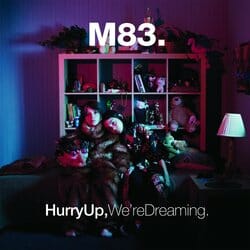 18. M83: Hurry Up We’re Dreaming
18. M83: Hurry Up We’re Dreaming
Maybe Anthony Gonzalez is just working his way back through the years, one album at a time. On his 2005 breakout as M83, Before the Dawn Heals Us, he took the shoegaze guitars of My Bloody Valentine and combined them with cinematic electronics with sci-fi trappings. For 2008’s Saturdays = Youth, he turned his space-loving disposition toward the John Hughes 1980s and all its synth-heavy jams. For his ambitious double-album Hurry Up, We’re Dreaming, Gonzalez digs even deeper into the ‘80s and even the late ‘70s, channeling Simple Minds here (“Reunion”) and Kraftwerk there (“Raconte-Moi Une Histoire”). As with everything the Frenchman’s done so far, the album is lush and ably produced, crescendo after crescendo. Zola Jesus guests, chiming guitars dominate and even some saxophone makes an appearance. Maybe he could tackle the Nuggets-era ‘60s next? —Austin L. Ray
 17. Cocteau Twins: TreasureTrying to sing along with Treasure is like trying to recite Harry Potter spells from memory: You’re just making up words as you go along, but who’s going to correct you? Heaven or Las Vegas is the critical favorite, but 1984’s Treasure is the album that crystallized the sound that would define Cocteau Twins’ career: swelling, euphoric dream-pop as a vehicle for Elizabeth Fraser’s heavenly vocals, which Genius annotations could never begin to crack. Guitarist Robin Guthrie is no slouch either, sculpting a small universe of woozy textures from his arsenal of effects pedals. From the big-beat bliss of “Lorelei” to the velvety murmurs of “Otterley” (which anticipates both ASMR and Beach House in five minutes or less), it’s an essential work from Scotland’s most revered importers of dream-pop. —Zach Schonfeld
17. Cocteau Twins: TreasureTrying to sing along with Treasure is like trying to recite Harry Potter spells from memory: You’re just making up words as you go along, but who’s going to correct you? Heaven or Las Vegas is the critical favorite, but 1984’s Treasure is the album that crystallized the sound that would define Cocteau Twins’ career: swelling, euphoric dream-pop as a vehicle for Elizabeth Fraser’s heavenly vocals, which Genius annotations could never begin to crack. Guitarist Robin Guthrie is no slouch either, sculpting a small universe of woozy textures from his arsenal of effects pedals. From the big-beat bliss of “Lorelei” to the velvety murmurs of “Otterley” (which anticipates both ASMR and Beach House in five minutes or less), it’s an essential work from Scotland’s most revered importers of dream-pop. —Zach Schonfeld
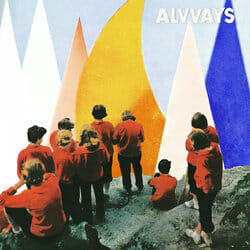 16. Alvvays: AntisocialitesOn Antisocialites, Alvvays haven’t lost their knack for writing concise indie pop songs that rival the best of Camera Obscura or Belle & Sebastian. By adding a warm synth sheen for their sophomore release, the Toronto-based quintet managed to make their jangly guitars seem even lusher. They’ve achieved what every band strives for on a sophomore album but most fail to do—namely, strike the middle ground between making the same record twice, and wanting to evolve and change their sound. By tweaking their songwriting ever so slightly, Alvvays one-up their 2014 breakthrough record. “Plimsoll Punks” plays like a fuller, more tightly wound “Next of Kin;” “Dreams Tonite” is a supercharged, groovier take on “Ones Who Love You.” Molly Rankin & co. have dissected every minute detail from their debut and figured out how to truly improve upon each part, one by one. Those small flourishes—a more pronounced synth line here, an unexpected key change there—don’t distract from what makes Alvvays great; they’ve only made the overall sound better. —Steven Edelstone
16. Alvvays: AntisocialitesOn Antisocialites, Alvvays haven’t lost their knack for writing concise indie pop songs that rival the best of Camera Obscura or Belle & Sebastian. By adding a warm synth sheen for their sophomore release, the Toronto-based quintet managed to make their jangly guitars seem even lusher. They’ve achieved what every band strives for on a sophomore album but most fail to do—namely, strike the middle ground between making the same record twice, and wanting to evolve and change their sound. By tweaking their songwriting ever so slightly, Alvvays one-up their 2014 breakthrough record. “Plimsoll Punks” plays like a fuller, more tightly wound “Next of Kin;” “Dreams Tonite” is a supercharged, groovier take on “Ones Who Love You.” Molly Rankin & co. have dissected every minute detail from their debut and figured out how to truly improve upon each part, one by one. Those small flourishes—a more pronounced synth line here, an unexpected key change there—don’t distract from what makes Alvvays great; they’ve only made the overall sound better. —Steven Edelstone
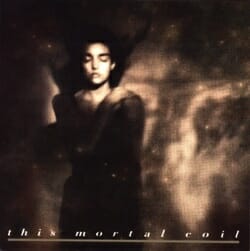 15. This Mortal Coil: It’ll End In TearsCalling this a supergroup feels like a bit of a misnomer, since its membership was fluid depending upon who was signed to 4AD Records or whose music was fascinating that label’s founder Ivo Watts-Russell at the time. So when the project kicked off in 1983, it included Cocteau Twins, Dead Can Dance, Modern English front man Robbie Grey and former Magazine/Buzzcocks member Howard Devoto, among many others. Their collective work on this 1984 release produced a dream pop album extraordinaire that was sleek and wistful, dark and seamy. It was also a chance for Watts-Russell to force some of his favorite songs upon his charges, which resulted in some of the album’s best moments, particularly the devastatingly beautiful version of Tim Buckley’s “Song To The Siren,” with a vocal turn by Elizabeth Fraser that feels like it can stop the world from turning. —Robert Ham
15. This Mortal Coil: It’ll End In TearsCalling this a supergroup feels like a bit of a misnomer, since its membership was fluid depending upon who was signed to 4AD Records or whose music was fascinating that label’s founder Ivo Watts-Russell at the time. So when the project kicked off in 1983, it included Cocteau Twins, Dead Can Dance, Modern English front man Robbie Grey and former Magazine/Buzzcocks member Howard Devoto, among many others. Their collective work on this 1984 release produced a dream pop album extraordinaire that was sleek and wistful, dark and seamy. It was also a chance for Watts-Russell to force some of his favorite songs upon his charges, which resulted in some of the album’s best moments, particularly the devastatingly beautiful version of Tim Buckley’s “Song To The Siren,” with a vocal turn by Elizabeth Fraser that feels like it can stop the world from turning. —Robert Ham
 14. Yo La Tengo: And Then Nothing Turned Itself-OutOn their ninth album, Yo La Tengo leaned heavily on their slow and quiet side. It might not have their dreamiest songs—that’d be the slow version of “Big Day Coming” that kicks off Painful, as well as “Blue Line Swinger” off Electr-o-pura and “Green Arrow” from I Can Hear the Heart Beating as One—but it’s their most consistently gentle and hushed album, with only one song approaching the loud guitar splatter Ira Kaplan is known for. It’s a record focused almost entirely on space—both the emotional and physical space between people, and the sound between notes and between instruments, the glow and hum of a guitar strum as it dissipates into a room, or the soft whir of a brushed drum. It can be goofy to talk about albums in context of seasons, but this is probably the most autumnal indie rock album ever released. —Garrett Martin
14. Yo La Tengo: And Then Nothing Turned Itself-OutOn their ninth album, Yo La Tengo leaned heavily on their slow and quiet side. It might not have their dreamiest songs—that’d be the slow version of “Big Day Coming” that kicks off Painful, as well as “Blue Line Swinger” off Electr-o-pura and “Green Arrow” from I Can Hear the Heart Beating as One—but it’s their most consistently gentle and hushed album, with only one song approaching the loud guitar splatter Ira Kaplan is known for. It’s a record focused almost entirely on space—both the emotional and physical space between people, and the sound between notes and between instruments, the glow and hum of a guitar strum as it dissipates into a room, or the soft whir of a brushed drum. It can be goofy to talk about albums in context of seasons, but this is probably the most autumnal indie rock album ever released. —Garrett Martin
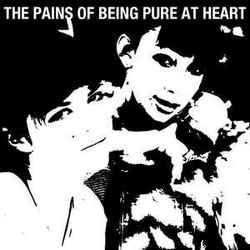 13. The Pains of Being Pure at Heart: The Pains of Being Pure at HeartAs far as modern dream pop goes, you’d be hard pressed to snub The Pains of Being Pure at Heart. The Brooklyn group’s debut album may sound like a playlist of all their favorite ’80s bands, but Kip Berman’s songs were more than up to par. Earnest and delicately sung, Berman’s voice is a warm nest as the band’s guitars fire off waves of fuzz. Their jangly twee sound was instantaneous, and the backing vocals from keyboardist Peggy Wang added an even sweeter benevolence. The harmonious noise-pop of “Stay Alive” and “Come Saturday” were amiable, but never overly sentimental—first and foremost, their songs were believable. Channeling the softer sides of Smashing Pumpkins and Ride and the bright indie-pop of The Pastels and Teenage Fanclub, The Pains of Being Pure at Heart aren’t exactly innovators, but they’re now referenced just as often as those other touchstone bands. —Lizzie Manno
13. The Pains of Being Pure at Heart: The Pains of Being Pure at HeartAs far as modern dream pop goes, you’d be hard pressed to snub The Pains of Being Pure at Heart. The Brooklyn group’s debut album may sound like a playlist of all their favorite ’80s bands, but Kip Berman’s songs were more than up to par. Earnest and delicately sung, Berman’s voice is a warm nest as the band’s guitars fire off waves of fuzz. Their jangly twee sound was instantaneous, and the backing vocals from keyboardist Peggy Wang added an even sweeter benevolence. The harmonious noise-pop of “Stay Alive” and “Come Saturday” were amiable, but never overly sentimental—first and foremost, their songs were believable. Channeling the softer sides of Smashing Pumpkins and Ride and the bright indie-pop of The Pastels and Teenage Fanclub, The Pains of Being Pure at Heart aren’t exactly innovators, but they’re now referenced just as often as those other touchstone bands. —Lizzie Manno
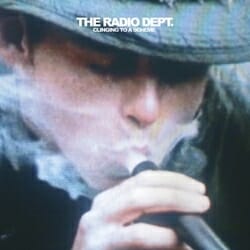 12. The Radio Dept.: Clinging to a SchemeNever before has dream pop sounded so warm, so welcoming. Every synth on Swedish band The Radio Dept.’s third album feels like a warm blanket, tucking you in while Johan Duncanson’s understated vocals read a bedtime story. Sometimes those stories are simple yet devastating (“Do I love you? / Yes I love you / But easy come, easy go / Don’t let me down” from the gorgeous “A Token of Gratitude”), other times longing for someone who will never love him back (“Oh David won’t you look into my eyes?”). Clinging to a Scheme, released in the first spring of this decade, does a lot by saying little; each lyric and guitar line carries a huge weight, each slowly-crooned word specifically chosen to convey a distinct emotion. Whether Duncanson is raging against the capitalists unfairly monetizing youth culture on breakthrough single “Heaven’s on Fire” or singing about the love interest he’s obsessed with on “The Video Dept.” through a mask of vocal distortion, The Radio Dept.’s masterpiece makes life’s littlest moments and emotions feel of utmost importance, each smile (or lack thereof) seemingly life-affirming or world-ending. The Swedish trio bids us farewell on the dazzling “You Stopped Making Sense,” a track about losing his romantic partner to religion, imploring his former significant other, “Don’t say goodbye.” In the almost 10 years since Clinging to a Scheme was released, we still haven’t. —Steven Edelstone
12. The Radio Dept.: Clinging to a SchemeNever before has dream pop sounded so warm, so welcoming. Every synth on Swedish band The Radio Dept.’s third album feels like a warm blanket, tucking you in while Johan Duncanson’s understated vocals read a bedtime story. Sometimes those stories are simple yet devastating (“Do I love you? / Yes I love you / But easy come, easy go / Don’t let me down” from the gorgeous “A Token of Gratitude”), other times longing for someone who will never love him back (“Oh David won’t you look into my eyes?”). Clinging to a Scheme, released in the first spring of this decade, does a lot by saying little; each lyric and guitar line carries a huge weight, each slowly-crooned word specifically chosen to convey a distinct emotion. Whether Duncanson is raging against the capitalists unfairly monetizing youth culture on breakthrough single “Heaven’s on Fire” or singing about the love interest he’s obsessed with on “The Video Dept.” through a mask of vocal distortion, The Radio Dept.’s masterpiece makes life’s littlest moments and emotions feel of utmost importance, each smile (or lack thereof) seemingly life-affirming or world-ending. The Swedish trio bids us farewell on the dazzling “You Stopped Making Sense,” a track about losing his romantic partner to religion, imploring his former significant other, “Don’t say goodbye.” In the almost 10 years since Clinging to a Scheme was released, we still haven’t. —Steven Edelstone
 11. The Sundays: Reading, Writing and ArithmeticWhile Seattle may have been a noisy place in the early ’90s, there were plenty of pockets of mellow for lovers of independent music, and few as were as memorable as Harriet Wheeler and David Gavurin’s band from Bristol, England. The Sundays created enough buzz from their first club shows to become quickly involved in a bidding war among labels, with Rough Trade earning the honors for their debut, Reading, Writing and Arithmetic. —Josh Jackson
11. The Sundays: Reading, Writing and ArithmeticWhile Seattle may have been a noisy place in the early ’90s, there were plenty of pockets of mellow for lovers of independent music, and few as were as memorable as Harriet Wheeler and David Gavurin’s band from Bristol, England. The Sundays created enough buzz from their first club shows to become quickly involved in a bidding war among labels, with Rough Trade earning the honors for their debut, Reading, Writing and Arithmetic. —Josh Jackson
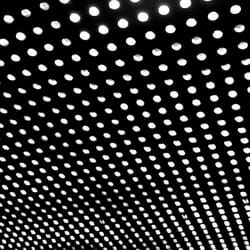 10. Beach House: BloomBloom picks up where Teen Dream left off, forgoing the more ambient sounds of the band’s first and second albums for more structured, hook-based songs. And much like its predecessor, Bloom’s sound is superficially light and whimsical, almost delicate—not unlike an actual blooming flower. Alex Scally masterfully crafts entrancing, methodical guitar arrangements that pair perfectly with Victoria Legrand’s gauzy voice to form a dreamy, almost ethereal-sounding pop album that’s as sweeping as it is audibly beautiful. The album proceeds like a lover who’s coping with the remains of a crumbled relationship. On “Lazuli,” Legrand trills, “make us suffer/like no other,” then laments, “nothing like lapis lazuli,” a reference to the rare, semi-precious stone. It’s as if Legrand takes on the role of someone convincing herself that love is nothing rare and is easily replaceable before the song crescendos in dramatic fashion to cries of “like no other, you can’t be replaced.” That’s always been Beach House’s formula: juxtaposing themes of heartbreak, loss and longing with hypnotic rhythms that build upon each other and careen hazily to a sparkling chorus. But the band does it with more force this time around. —Michell Eloy
10. Beach House: BloomBloom picks up where Teen Dream left off, forgoing the more ambient sounds of the band’s first and second albums for more structured, hook-based songs. And much like its predecessor, Bloom’s sound is superficially light and whimsical, almost delicate—not unlike an actual blooming flower. Alex Scally masterfully crafts entrancing, methodical guitar arrangements that pair perfectly with Victoria Legrand’s gauzy voice to form a dreamy, almost ethereal-sounding pop album that’s as sweeping as it is audibly beautiful. The album proceeds like a lover who’s coping with the remains of a crumbled relationship. On “Lazuli,” Legrand trills, “make us suffer/like no other,” then laments, “nothing like lapis lazuli,” a reference to the rare, semi-precious stone. It’s as if Legrand takes on the role of someone convincing herself that love is nothing rare and is easily replaceable before the song crescendos in dramatic fashion to cries of “like no other, you can’t be replaced.” That’s always been Beach House’s formula: juxtaposing themes of heartbreak, loss and longing with hypnotic rhythms that build upon each other and careen hazily to a sparkling chorus. But the band does it with more force this time around. —Michell Eloy
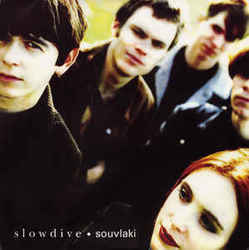 9. Slowdive: SouvlakiSouvlaki makes for the rare shoegaze album with a lyrical and emotional depth to match its formidable sonic depth. And its not-too-well-kept secret is that it’s a breakup album. Rachel Goswell and Neil Halstead, Slowdive’s dual vocalists, knew each other since school days. Internet legend has it that they were romantically intertwined but dissolved their personal relationship before Souvlaki. The members have only ever hinted at such a scenario, but it would more than explain the heavy pall of heartbreak that hangs over Souvlaki. “Forty days and I miss you / I’m so high that I lost my mind,” Halstead sings on the noisy and desperate “40 Days.” The closing “Dagger” is even more devastating: “You know I am your dagger / You know I am your wound / I thought I heard you whisper / It happens all the time.” Souvlaki, then, is the Rumours for the dream-pop set, a bracing chronicle of heartbreak that finds each contributors to that heartbreak playing equal roles. —Zach Schonfeld
9. Slowdive: SouvlakiSouvlaki makes for the rare shoegaze album with a lyrical and emotional depth to match its formidable sonic depth. And its not-too-well-kept secret is that it’s a breakup album. Rachel Goswell and Neil Halstead, Slowdive’s dual vocalists, knew each other since school days. Internet legend has it that they were romantically intertwined but dissolved their personal relationship before Souvlaki. The members have only ever hinted at such a scenario, but it would more than explain the heavy pall of heartbreak that hangs over Souvlaki. “Forty days and I miss you / I’m so high that I lost my mind,” Halstead sings on the noisy and desperate “40 Days.” The closing “Dagger” is even more devastating: “You know I am your dagger / You know I am your wound / I thought I heard you whisper / It happens all the time.” Souvlaki, then, is the Rumours for the dream-pop set, a bracing chronicle of heartbreak that finds each contributors to that heartbreak playing equal roles. —Zach Schonfeld
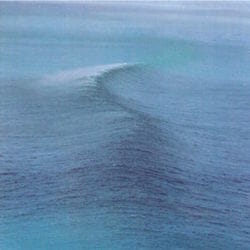 8. Ride: NowhereRide is another pioneer of the dream pop and shoegaze genres, and their debut, Nowhere, is oft-cited as one of the best albums of all time. Emerging from England in the early ’90s, the band is able to reflect the influence of bands like Stone Roses, Sonic Youth and The Cure through its harsh, discordant sound. As a result, Nowhere is a collection of reverberated songs that stand effortlessly posed between digestible pop songs and sonic, intense noise-rock. —Samantha Lopez
8. Ride: NowhereRide is another pioneer of the dream pop and shoegaze genres, and their debut, Nowhere, is oft-cited as one of the best albums of all time. Emerging from England in the early ’90s, the band is able to reflect the influence of bands like Stone Roses, Sonic Youth and The Cure through its harsh, discordant sound. As a result, Nowhere is a collection of reverberated songs that stand effortlessly posed between digestible pop songs and sonic, intense noise-rock. —Samantha Lopez
 7. Sigur Rós: ( )Dream pop is all about feeling, and Sigur Ros’ ( ) embodies that. Sure, the trappings of an untitled album full of untitled tracks sung in a made-up language and split into two light and dark parts is a hat on a pretentious hat. But when you strip that away—and the whole point of it is that you should—what you’re left with is pure feeling. Nothing backs that up as much as the fact that almost all of the album’s tracks have been used or sampled at key moments in major films and TV shows, at times when you are meant to be awash in emotions heightened by these thoughtful, deep Icelandic musings. What you hear in the repeated 11-syllable phrase “You xylo. You xylo no fi lo. You so.” is a sonic Rorschach test of the soul, unique to each experience. —Allison Keene
7. Sigur Rós: ( )Dream pop is all about feeling, and Sigur Ros’ ( ) embodies that. Sure, the trappings of an untitled album full of untitled tracks sung in a made-up language and split into two light and dark parts is a hat on a pretentious hat. But when you strip that away—and the whole point of it is that you should—what you’re left with is pure feeling. Nothing backs that up as much as the fact that almost all of the album’s tracks have been used or sampled at key moments in major films and TV shows, at times when you are meant to be awash in emotions heightened by these thoughtful, deep Icelandic musings. What you hear in the repeated 11-syllable phrase “You xylo. You xylo no fi lo. You so.” is a sonic Rorschach test of the soul, unique to each experience. —Allison Keene
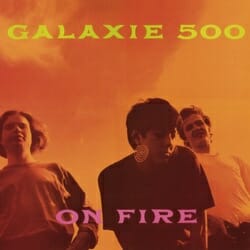 6. Galaxie 500: On FireBoston dream pop outfit Galaxie 500 weren’t around for very long, but the influence of their downtempo, reverb-filled three albums is still glaringly present today. Their second album On Fire is a cornerstone of dream-pop bashfulness and trippy lo-fi rock, and it remains their strongest full-length. Dean Wareham’s voice isn’t exceptional by any stretch of the imagination, but he cultivates something imposing out of his humble means. Their debut Today still stands out for swaying minimalist cuts like “Tugboat” and their cover of Jonathan Richman’s “Don’t Let Our Youth Go to Waste,” but where On Fire bests it is in its slow thrash and more diverse instrumentation. The guitar solo in “When Will You Come Home” isn’t stereotypically dream pop—it grooves and drips and definitely doesn’t cower under the spotlight—but the juxtaposition of this self-assured, flare-filled tangent with delicate vocals and shy, boy-next-door lyrics is incredibly moving. On “Another Day,” bassist Naomi Yang’s dainty lead vocals are just as crushing as Wareham’s psychedelic guitar tumbles, and lead track “Blue Thunder” proves there’s a sheer force in plain, headstrong strums and good-natured vocals. —Lizzie Manno
6. Galaxie 500: On FireBoston dream pop outfit Galaxie 500 weren’t around for very long, but the influence of their downtempo, reverb-filled three albums is still glaringly present today. Their second album On Fire is a cornerstone of dream-pop bashfulness and trippy lo-fi rock, and it remains their strongest full-length. Dean Wareham’s voice isn’t exceptional by any stretch of the imagination, but he cultivates something imposing out of his humble means. Their debut Today still stands out for swaying minimalist cuts like “Tugboat” and their cover of Jonathan Richman’s “Don’t Let Our Youth Go to Waste,” but where On Fire bests it is in its slow thrash and more diverse instrumentation. The guitar solo in “When Will You Come Home” isn’t stereotypically dream pop—it grooves and drips and definitely doesn’t cower under the spotlight—but the juxtaposition of this self-assured, flare-filled tangent with delicate vocals and shy, boy-next-door lyrics is incredibly moving. On “Another Day,” bassist Naomi Yang’s dainty lead vocals are just as crushing as Wareham’s psychedelic guitar tumbles, and lead track “Blue Thunder” proves there’s a sheer force in plain, headstrong strums and good-natured vocals. —Lizzie Manno
 5. Beach House: Teen DreamTeen Dream sounds just like Beach House and not at all like Beach House. On their first two albums, Victoria Legrand and Alex Scally created warm, lo-fi pop songs that favored subdued ambience over pronounced hooks, as if each song was designed to dissipate in the air between the speakers and your ears. By contrast, the duo’s Teen Dream songs are less hazy and more forceful—they actually project. Singing in a bold style that suggests a huskier-voiced Kate Bush, Legrand sounds androgynous on “Walk in the Park” and breathy on “Norway.” Scally, meanwhile, creates prickly arrangements full of narcotic guitars, reverbed piano and woozy synths that shimmer over spare, steady percussion. Dream is a go-for-broke collection that not only creates and sustains a hi-fi drowse-pop drama throughout its 10 beguiling songs, but comes across like a logical and gorgeous extension of all the band’s previous dreams. —Stephen M. Deusner
5. Beach House: Teen DreamTeen Dream sounds just like Beach House and not at all like Beach House. On their first two albums, Victoria Legrand and Alex Scally created warm, lo-fi pop songs that favored subdued ambience over pronounced hooks, as if each song was designed to dissipate in the air between the speakers and your ears. By contrast, the duo’s Teen Dream songs are less hazy and more forceful—they actually project. Singing in a bold style that suggests a huskier-voiced Kate Bush, Legrand sounds androgynous on “Walk in the Park” and breathy on “Norway.” Scally, meanwhile, creates prickly arrangements full of narcotic guitars, reverbed piano and woozy synths that shimmer over spare, steady percussion. Dream is a go-for-broke collection that not only creates and sustains a hi-fi drowse-pop drama throughout its 10 beguiling songs, but comes across like a logical and gorgeous extension of all the band’s previous dreams. —Stephen M. Deusner
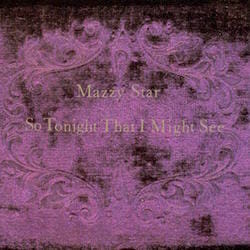 4. Mazzy Star: So Tonight That I Might SeeThe ethereal shimmer of distorted electric guitar and synthesizers most closely associated with dream pop is nowhere to be found on Mazzy Star’s essential sophomore album. Instead, the duo born out of California’s Paisley Underground in the late ’80s carry that scene’s gentle, melodic psychedelia forward, melding blues-rock shuffle (“Wasted”) and ambient organ hum (“Mary of Silence”), achingly lovely strings (“Five String Serenade”) and rumbling hand percussion (“Unreflected”), to produce a warmer, more intimate form of the dream pop subgenre. So Tonight That I Might See is forever defined by its opener, the duo’s beloved hit “Fade Into You,” which makes longing magic out of Hope Sandoval’s velvet voice, subdued acoustic chords and keys, wistful slide guitar and little else. But Mazzy Star cast that same atmospheric spell across all 10 of these tracks, downtempo reveries accented by Sandoval-tapped tambourine and David Roback’s subtly twangy guitar riffs—songs with all the entrancing pull of those first moments of lost consciousness, with boundless space for a roving imagination. —Scott Russell
4. Mazzy Star: So Tonight That I Might SeeThe ethereal shimmer of distorted electric guitar and synthesizers most closely associated with dream pop is nowhere to be found on Mazzy Star’s essential sophomore album. Instead, the duo born out of California’s Paisley Underground in the late ’80s carry that scene’s gentle, melodic psychedelia forward, melding blues-rock shuffle (“Wasted”) and ambient organ hum (“Mary of Silence”), achingly lovely strings (“Five String Serenade”) and rumbling hand percussion (“Unreflected”), to produce a warmer, more intimate form of the dream pop subgenre. So Tonight That I Might See is forever defined by its opener, the duo’s beloved hit “Fade Into You,” which makes longing magic out of Hope Sandoval’s velvet voice, subdued acoustic chords and keys, wistful slide guitar and little else. But Mazzy Star cast that same atmospheric spell across all 10 of these tracks, downtempo reveries accented by Sandoval-tapped tambourine and David Roback’s subtly twangy guitar riffs—songs with all the entrancing pull of those first moments of lost consciousness, with boundless space for a roving imagination. —Scott Russell
 3. The Cure: DisintegrationDisintegration is a return to goth glory after The Cure’s foray into pop with 1987’s Kiss Me, Kiss Me, Kiss Me. It’s lush, mournful and gorgeous—in other words, it’s Robert Smith and company at their very best. From the first notes of “Plainsong” to the somber romance of “Lovesong” and the sweeping “Fascination Street,” the album is emotional but never overwrought. Smith surpasses hokey teen angst, instead creating a lasting work that’s entirely relatable. —Bonnie Stiernberg
3. The Cure: DisintegrationDisintegration is a return to goth glory after The Cure’s foray into pop with 1987’s Kiss Me, Kiss Me, Kiss Me. It’s lush, mournful and gorgeous—in other words, it’s Robert Smith and company at their very best. From the first notes of “Plainsong” to the somber romance of “Lovesong” and the sweeping “Fascination Street,” the album is emotional but never overwrought. Smith surpasses hokey teen angst, instead creating a lasting work that’s entirely relatable. —Bonnie Stiernberg
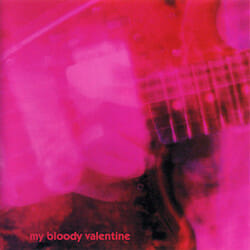 2. My Bloody Valentine: LovelessIt’s hard to think of an album in the ’90s whose genesis created as much frustration, effort, money and, ultimately, critical acclaim as My Bloody Valentine’s Loveless. The album, which was recorded in 19 studios and briefly employed gobs of recording engineers over two years, took all of this effort for a reason: Nothing else sounded remotely like it when it was released. Kevin Shields’ shapeless, impossibly distorted guitar parts perfectly complemented vocalist Bilinda Butcher’s whispered melodies that played up the idea of using a voice as an instrument. Loveless’ most iconic tracks, the shrieking guitar-driven “Only Shallow” and the mellowed, droning ballad “Sometimes,” show that the band wasn’t just made up of sonic visionaries—there were true songwriters behind the noise.—Tyler Kane
2. My Bloody Valentine: LovelessIt’s hard to think of an album in the ’90s whose genesis created as much frustration, effort, money and, ultimately, critical acclaim as My Bloody Valentine’s Loveless. The album, which was recorded in 19 studios and briefly employed gobs of recording engineers over two years, took all of this effort for a reason: Nothing else sounded remotely like it when it was released. Kevin Shields’ shapeless, impossibly distorted guitar parts perfectly complemented vocalist Bilinda Butcher’s whispered melodies that played up the idea of using a voice as an instrument. Loveless’ most iconic tracks, the shrieking guitar-driven “Only Shallow” and the mellowed, droning ballad “Sometimes,” show that the band wasn’t just made up of sonic visionaries—there were true songwriters behind the noise.—Tyler Kane
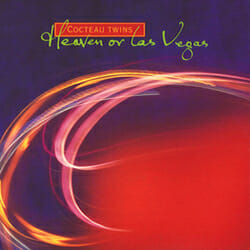 1. Cocteau Twins: Heaven or Las VegasDream pop’s most influential band created its masterpiece amidst pregnancies, marriages, deaths, addictions and relationship failures, but you might not know it from listening. Cocteau Twins all but introduced the concept of glossolalia to pop music, and you’d be hard-pressed to clearly make out more than a few passing phrases—“I only want to love you,” “burn this whole madhouse down,” “my baby’s cries”—while listening to Heaven or Las Vegas. And that’s not the craziest part: When the Scottish trio released this landmark album in 1990, many critics said that frontperson Elizabeth Fraser had never sounded clearer. Fair enough given the LP’s five predecessors, but the joy of Heaven or Las Vegas is that you don’t need to know what Fraser is saying (even if the few discernible lyrics are immensely personal) to fall into a stupor. Her technicolor trills are as sweeping as a warm summer breeze, Robin Guthrie’s guitars and drum programming sparkle and echo as entrancingly as a hypnotist’s pendulum and Simon Raymonde’s bass and piano are as immersive as a five-star spa’s hot tub. “Frou-Frou Foxes In Midsummer Fires” is the climactic closer and “Pitch the Baby” is the vaguely trance-like early highlight, but the title track is the album’s literal and figurative centerpiece (and perhaps dream pop’s all-time pinnacle). Atop guitars that gleam like diamonds, pianos that drip like water and a hefty whisper of a drum shuffle, Frasier’s voice resounds so beautifully it’s literally stunning. At one point she sings (fully audibly!), “It must be why I’m thinking of Las Vegas,” but dream pop’s best album is entirely heaven. —Max Freedman
1. Cocteau Twins: Heaven or Las VegasDream pop’s most influential band created its masterpiece amidst pregnancies, marriages, deaths, addictions and relationship failures, but you might not know it from listening. Cocteau Twins all but introduced the concept of glossolalia to pop music, and you’d be hard-pressed to clearly make out more than a few passing phrases—“I only want to love you,” “burn this whole madhouse down,” “my baby’s cries”—while listening to Heaven or Las Vegas. And that’s not the craziest part: When the Scottish trio released this landmark album in 1990, many critics said that frontperson Elizabeth Fraser had never sounded clearer. Fair enough given the LP’s five predecessors, but the joy of Heaven or Las Vegas is that you don’t need to know what Fraser is saying (even if the few discernible lyrics are immensely personal) to fall into a stupor. Her technicolor trills are as sweeping as a warm summer breeze, Robin Guthrie’s guitars and drum programming sparkle and echo as entrancingly as a hypnotist’s pendulum and Simon Raymonde’s bass and piano are as immersive as a five-star spa’s hot tub. “Frou-Frou Foxes In Midsummer Fires” is the climactic closer and “Pitch the Baby” is the vaguely trance-like early highlight, but the title track is the album’s literal and figurative centerpiece (and perhaps dream pop’s all-time pinnacle). Atop guitars that gleam like diamonds, pianos that drip like water and a hefty whisper of a drum shuffle, Frasier’s voice resounds so beautifully it’s literally stunning. At one point she sings (fully audibly!), “It must be why I’m thinking of Las Vegas,” but dream pop’s best album is entirely heaven. —Max Freedman